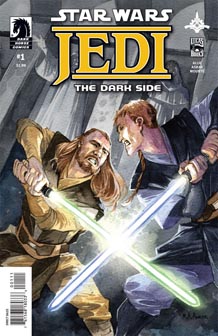Part of Disney’s argument for why the “Star Wars” timeline had to be rebooted was that a new movie on the original timeline couldn’t be understood by a newcomer who didn’t know the wider story. This is easily disproven by the whole history of “Star Wars” stories, which had been told non-linearly since the beginning, when our first glimpse of the saga was the “fourth” episode.
And there are many more examples of stories told out of order (ironically, Disney’s “Episode VII” is one of them, as viewers aren’t privy to many story points since the previous movie) – and therefore inevitably experienced out of order by fans.
Take, for instance, “Jedi: The Dark Side” (2011). This five-issue comic series tells the backstory of dark-sider Xanatos, who was introduced as a nemesis to Qui-Gon and young Obi-Wan in the “Jedi Apprentice” junior-readers series, which began even before “Episode I” hit theaters in 1999. In the second book of that series, which is set just before “The Phantom Menace,” Qui-Gon touches on how his former Padawan Xanatos fell to the dark side. As part of the brief multimedia push around the time of “Episode I’s” 3D release in early 2012, Dark Horse gave us this story.
While it has added depth for those who read the “Jedi Apprentice” series, it works fine on its own, too — as I can attest, having not read “Jedi Apprentice.” (By the way, this really should be called “Jedi Apprentice: The Dark Side,” especially since there is another series set during the Clone Wars called “Jedi.”)
Dark Horse editor and writer Scott Allie is always solid, but this might be his most confident “Star Wars” work. Unlike Ryder Windham’s “Jedi Quest,” an adaptation of an Obi-Wan/Anakin junior-reader tale that carried over the young reader feel, “Jedi: The Dark Side” is an adult story. Assisted by solid art from Mahmud Asrar, who nicely imparts characters’ feelings through facial expressions, this series has a familiar, layered plot of political corruption on a planet – in this case, Talos, which has a history in the “Knights of the Old Republic” video game (and to a lesser extent, the comic series).
But it mainly works as a character piece: Qui-Gon; Xanatos (a male human); Master Tahl (a Noorian female); and Padawan Orykan (a Twi’lek female), whose master had recently died, are the four protagonists. Xanatos is somewhat of a whiny brat, but I didn’t find him unappealing because I was focused on Qui-Gon. In a way, Anakin Skywalker’s fall to the dark side is a tragic tale of hubris where Yoda, Obi-Wan, Mace Windu and the whole Jedi Order deserve some blame. That goes back further to Qui-Gon, as we see here: He is never able to give his Padawan the direction he needs. He believes he can train Xanatos properly, but he’s wrong, just as Obi-Wan would later fail with Anakin.

(Of course, this theory side-steps the fact that Qui-Gon did just fine training Obi-Wan. But it seems Qui-Gon got lucky with Obi-Wan being a model student — or so I assume; more on young Obi-Wan can be found in “Jedi Apprentice” — but with Xanatos he was not so lucky. Certainly, although Qui-Gon is a lovable character, he’s also a bit arrogant and assuming. If he passed on some of those traits to Obi-Wan, who then failed with Anakin – who absorbed some of those traits in a more negative way – then the whole tragic story can be traced back to Qui-Gon’s failure to learn from “Jedi: The Dark Side.”)
Interestingly, while the Jedi Order wisely believes it’s important that children become charges of the Jedi Temple pretty much from birth, that policy doesn’t stop all Padawans from becoming emotionally unstable around their teenage years. Indeed, Xanatos is angry because his father gave him up to the Jedi Order. Qui-Gon asks Xanatos to try to forgive his father, but when it turns out the father is the manipulator of the upheaval on Talos, the success of Qui-Gon’s guidance backfires: The youth is now allied with the bad guys.
Adding depth to the yarn, we get a sense of flirtatiousness between Tahl and Qui-Gon and the notion that they might be lovers if the Order didn’t discourage it. And Orykan is a refreshingly green (not just in skin tone) young Padawan. I like how everything about the mission is world-shaking for her, and how Qui-Gon and Tahl treat her with kid-gloves. After all, this story is set well before the Clone Wars, when Padawans had to be rushed into peacemaker duty. While Tahl’s arc finds completeness in “Jedi Apprentice,” Orykan is unfortunately never seen again.
Orykan fading into the mists of EU lore might mean she’s one of the many continuity victims of the EU’s cancellation by Disney, but to be fair, the Clone Wars timeline was already pretty jam-packed by 2011, so it would’ve been hard to find room for her – so yes, there are sometimes consequences to telling stories out of order.
But I get the feeling that there was at least a notion that the “Jedi” series might continue, since it ends with Qui-Gon refusing Yoda’s order to return to the Temple, as he needs time to himself to reflect on his failure as a teacher. I think we needed one more adult-comic story in the gap between “Jedi: The Dark Side” and “Jedi Apprentice” – or perhaps an adult-leaning “Jedi Apprentice” adaptation — to show how Qui-Gon never did totally grasp his missteps.
Nonetheless, it’s still nice to get the pivotal glimpse into Qui-Gon’s past provided by “Jedi: The Dark Side.”

